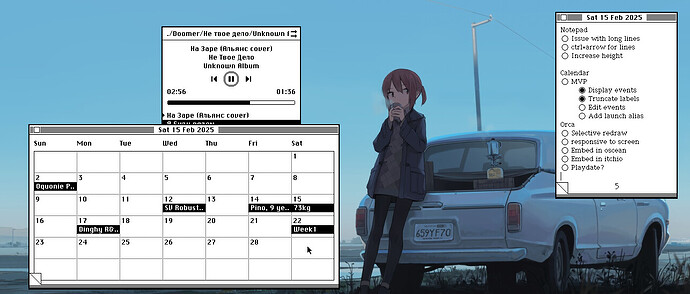Someone asked me today if I could make a pretty basic implementation of the VM without all the device code and stuff, just consol I/O. So I did, here it is, it passes all opcode tests:
#include <stdio.h>
typedef unsigned char Uint8;
typedef signed char Sint8;
typedef unsigned short Uint16;
typedef struct {
Uint8 dat[0x100], ptr;
} Stack;
typedef struct Uxn {
Uint8 ram[0x10000], dev[0x100];
Stack wst, rst;
} Uxn;
int uxn_eval(Uxn *u, Uint16 pc);
int
console_input(Uxn *u, char c, int type)
{
Uint16 vector = u->dev[0x10] << 8 | u->dev[0x11];
u->dev[0x12] = c, u->dev[0x17] = type;
return uxn_eval(u, vector);
}
Uint8
emu_dei(Uxn *u, Uint8 addr)
{
return u->dev[addr];
}
void
emu_deo(Uxn *u, Uint8 addr, Uint8 value)
{
u->dev[addr] = value;
switch(addr) {
case 0x18: fputc(u->dev[0x18], stdout), fflush(stdout); return;
case 0x19: fputc(u->dev[0x19], stderr), fflush(stderr); return;
}
}
#define FLIP { s = ins & 0x40 ? &u->wst : &u->rst; }
#define JUMP(x) { if(m2) pc = (x); else pc += (Sint8)(x); }
#define POP1(o) { o = s->dat[--*sp]; }
#define POP2(o) { o = s->dat[--*sp] | (s->dat[--*sp] << 0x8); }
#define POPx(o) { if(m2) { POP2(o) } else POP1(o) }
#define PUSH1(y) { s->dat[s->ptr++] = (y); }
#define PUSH2(y) { tt = (y); s->dat[s->ptr++] = tt >> 0x8; s->dat[s->ptr++] = tt; }
#define PUSHx(y) { if(m2) { PUSH2(y) } else PUSH1(y) }
#define PEEK(o, x, r) { if(m2) { r = (x); o = ram[r++] << 8 | ram[r]; } else o = ram[(x)]; }
#define POKE(x, y, r) { if(m2) { r = (x); ram[r++] = y >> 8; ram[r] = y; } else ram[(x)] = (y); }
#define DEVR(o, p) { if(m2) { o = (emu_dei(u, p) << 8) | emu_dei(u, p + 1); } else o = emu_dei(u, p); }
#define DEVW(p, y) { if(m2) { emu_deo(u, p, y >> 8); emu_deo(u, p + 1, y); } else emu_deo(u, p, y); }
int
uxn_eval(Uxn *u, Uint16 pc)
{
Uint8 t, kp, *sp, *ram = u->ram;
Uint16 tt, a, b, c;
if(!pc || u->dev[0x0f]) return 0;
for(;;) {
Uint8 ins = ram[pc++], m2 = ins & 0x20;
Stack *s = ins & 0x40 ? &u->rst : &u->wst;
if(ins & 0x80) kp = s->ptr, sp = &kp;
else sp = &s->ptr;
switch(ins & 0x1f) {
case 0x00: case 0x20:
switch(ins) {
case 0x00: /* BRK */ return 1;
case 0x20: /* JCI */ POP1(b) if(!b) { pc += 2; break; }
case 0x40: /* JMI */ a = ram[pc++] << 8 | ram[pc++]; pc += a; break;
case 0x60: /* JSI */ PUSH2(pc + 2) a = ram[pc++] << 8 | ram[pc++]; pc += a; break;
case 0x80: case 0xc0: /* LIT */ PUSH1(ram[pc++]) break;
case 0xa0: case 0xe0: /* LIT2 */ PUSH1(ram[pc++]) PUSH1(ram[pc++]) break;
} break;
case 0x01: /* INC */ POPx(a) PUSHx(a + 1) break;
case 0x02: /* POP */ POPx(a) break;
case 0x03: /* NIP */ POPx(a) POPx(b) PUSHx(a) break;
case 0x04: /* SWP */ POPx(a) POPx(b) PUSHx(a) PUSHx(b) break;
case 0x05: /* ROT */ POPx(a) POPx(b) POPx(c) PUSHx(b) PUSHx(a) PUSHx(c) break;
case 0x06: /* DUP */ POPx(a) PUSHx(a) PUSHx(a) break;
case 0x07: /* OVR */ POPx(a) POPx(b) PUSHx(b) PUSHx(a) PUSHx(b) break;
case 0x08: /* EQU */ POPx(a) POPx(b) PUSH1(b == a) break;
case 0x09: /* NEQ */ POPx(a) POPx(b) PUSH1(b != a) break;
case 0x0a: /* GTH */ POPx(a) POPx(b) PUSH1(b > a) break;
case 0x0b: /* LTH */ POPx(a) POPx(b) PUSH1(b < a) break;
case 0x0c: /* JMP */ POPx(a) JUMP(a) break;
case 0x0d: /* JCN */ POPx(a) POP1(b) if(b) JUMP(a) break;
case 0x0e: /* JSR */ POPx(a) FLIP PUSH2(pc) JUMP(a) break;
case 0x0f: /* STH */ POPx(a) FLIP PUSHx(a) break;
case 0x10: /* LDZ */ POP1(a) PEEK(b, a, t) PUSHx(b) break;
case 0x11: /* STZ */ POP1(a) POPx(b) POKE(a, b, t) break;
case 0x12: /* LDR */ POP1(a) PEEK(b, pc + (Sint8)a, tt) PUSHx(b) break;
case 0x13: /* STR */ POP1(a) POPx(b) POKE(pc + (Sint8)a, b, tt) break;
case 0x14: /* LDA */ POP2(a) PEEK(b, a, tt) PUSHx(b) break;
case 0x15: /* STA */ POP2(a) POPx(b) POKE(a, b, tt) break;
case 0x16: /* DEI */ POP1(a) DEVR(b, a) PUSHx(b) break;
case 0x17: /* DEO */ POP1(a) POPx(b) DEVW(a, b) break;
case 0x18: /* ADD */ POPx(a) POPx(b) PUSHx(b + a) break;
case 0x19: /* SUB */ POPx(a) POPx(b) PUSHx(b - a) break;
case 0x1a: /* MUL */ POPx(a) POPx(b) PUSHx(b * a) break;
case 0x1b: /* DIV */ POPx(a) POPx(b) PUSHx(a ? b / a : 0) break;
case 0x1c: /* AND */ POPx(a) POPx(b) PUSHx(b & a) break;
case 0x1d: /* ORA */ POPx(a) POPx(b) PUSHx(b | a) break;
case 0x1e: /* EOR */ POPx(a) POPx(b) PUSHx(b ^ a) break;
case 0x1f: /* SFT */ POP1(a) POPx(b) PUSHx(b >> (a & 0xf) << (a >> 4)) break;
}
}
}
int
main(int argc, char **argv)
{
FILE *f;
int i = 1;
Uxn u = {0};
if(i == argc) {
fprintf(stdout, "usage: %s file.rom [args..]\n", argv[0]);
return 0;
}
f = fopen(argv[i++], "rb");
if(!f) {
fprintf(stderr, "Failed to initialize %s\n", argv[1]);
return 0;
}
fread(&u.ram[0x0100], 0xff00, 1, f);
fclose(f);
u.dev[0x17] = argc - i;
if(uxn_eval(&u, 0x0100)) {
for(; i < argc; i++) {
char *p = argv[i];
while(*p) console_input(&u, *p++, 0x2);
console_input(&u, '\n', i == argc - 1 ? 0x4 : 0x3);
}
while(!u.dev[0x0f]) {
char c = fgetc(stdin);
if(c == EOF) {
console_input(&u, 0x00, 0x4);
break;
}
console_input(&u, (Uint8)c, 0x1);
}
}
return u.dev[0x0f] & 0x7f;
}

